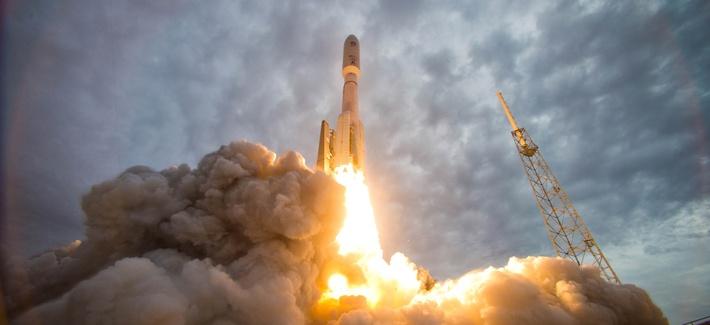
Two RD-180 rocket engines, currently produced using the Russian-manufactured pre-burner.
3D printing enters the arenas of international diplomacy and outer space as US and Russian relations chill and the Pentagon seeks alternatives to previous high-tech trade arrangements. With the turmoil in the east, particularly Russia’s invasion of Ukraine, the US has been forced to reconsider its options in terms of acquiring a critical component of the military’s reconnaissance, communication, and navigation satellite program. Getting those satellites into orbit has meant relying on Russia to supply the powerful RD-180 engine that blasts the Atlas V rocket into space. The engine is the star player in the boost phase, the critical first four minutes or so of the launch. After those first four minutes, the RD-180 and the booster disconnect and another engine, the RL-10, takes over, advancing the payload into space.
Something of a national crisis, albeit one that has gone for the most part unpublicized, has developed because of problematic relations between the US and Russia, and the Pentagon an d Congress have turned to US companies for potential solutions. Enter 3D printing, or additive manufacturing, which is proving to be at least a partial solution to the problem. Two companies — Dynetics in Huntsville, Alabama, and Aerojet Rocketdyne of Sacramento, California — have begun building replacement engines in lieu of getting the RD-180 from Russia, and they’re using 3D printing to create a major engine component: the pre-burner.
d Congress have turned to US companies for potential solutions. Enter 3D printing, or additive manufacturing, which is proving to be at least a partial solution to the problem. Two companies — Dynetics in Huntsville, Alabama, and Aerojet Rocketdyne of Sacramento, California — have begun building replacement engines in lieu of getting the RD-180 from Russia, and they’re using 3D printing to create a major engine component: the pre-burner.
The pre-burner is the part of the engine that generates the hot gas that turns on the turbo pump in the main engine of the rocket. The research and development team at Dynetics, which has been working on this project for two years, has managed to produce the part in 15 days using 3D printing. This short turnaround is all the more more remarkable given that, with traditional manufacturing process it takes up to 15 months to make the pre-burner. Clearly, this is a significant savings of both time and money, which makes the number crunchers in Congress and the Pentagon exceedingly happy.
“Going to additive manufacturing is going to be one of the biggest cost and time savers on this engine,” said Steve Cook, director of corporate development at Dynetics.
The promise of 3D printing’s applicability in the production of the pre-burner and potentially other aspects of the rocket’s manufacture means that the US can now be less reliant on foreign interests in facilitating a critical aspect of national security, so it probably goes without saying that this is a major breakthrough and 3D printing is at the center of it.
This development has also inspired the Pentagon and Congress to put their support, including much-needed financing — $40 million has just been allotted — behind converting manufacturing of the RD-180 engine completely to US manufacturers, which is good news for US industry. It is thought that a completely US-produced RD-180 rocket engine will be completed by 2019. Other US manufacturers, including Blue Origin, founded by Jeff Bezos of Amazon fame, and United Launch Alliance (ULA), are also getting involved in the effort to produce the RD-180 fully in the US and will be part of the ensuing bidding contest for important government contracts, with some of the companies proposing a solid-fuel rocket and others, including Blue Origin and ULA, offering a liquid-fueled version of the powerful engine. Let’s hear your thoughts on this story in the 3D Printed Rocket forum thread on 3DPB.com.

Subscribe to Our Email Newsletter
Stay up-to-date on all the latest news from the 3D printing industry and receive information and offers from third party vendors.
You May Also Like
3D Printing News Briefs, April 13, 2024: Robotics, Orthotics, & Hypersonics
In 3D Printing News Briefs today, we’re focusing first on robotics, as Carnegie Mellon University’s new Robotics Innovation Center will house several community outreach programs, and Ugogo3D is now working...
Rail Giant Alstom Saves $15M with 3D Printing Automation Software 3D Spark
3D Spark has entered into a three-year deal with the rail giant Alstom. Alstom, a transport behemoth with annual revenues of $16 billion, specializes in the manufacture of trains, trams,...
Meltio Expands Global Reach with New Partnerships in the Americas and Europe
Spanish 3D printing manufacturer Meltio has expanded its sales network across the globe. With the addition of three new partners in the United States, Brazil, Argentina, and Italy, Meltio aims...
3D Printing Webinar and Event Roundup: April 7, 2024
Webinars and events in the 3D printing industry are picking back up this week! Sea-Air-Space is coming to Maryland, and SAE International is sponsoring a 3D Systems webinar about 3D...































